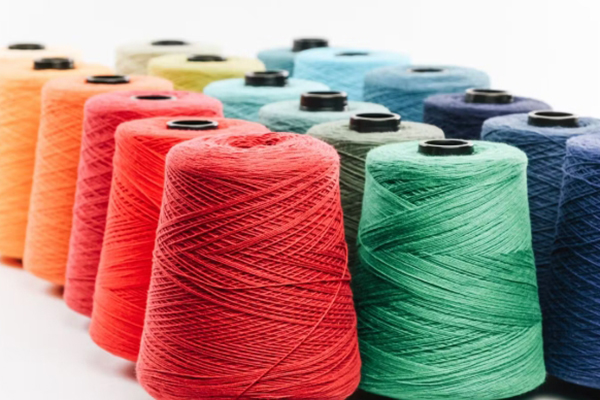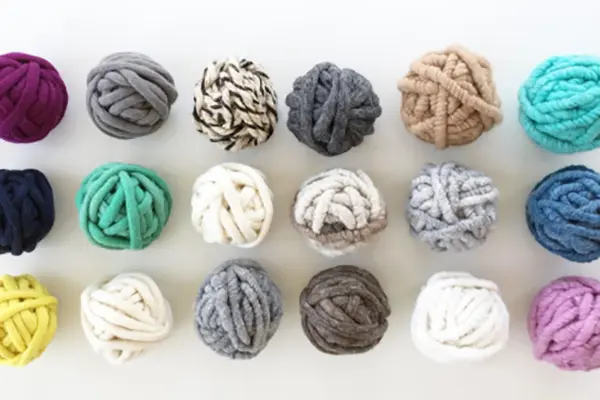Choosing the right yarn for your weaving project is the single most important decision you’ll make before you even thread your loom. The yarn you select determines the strength, feel, and function of your final cloth. Get it right, and you’ll create a beautiful, durable piece. Get it wrong, and you might face frustrating breakage on the loom or a final product that doesn’t live up to your vision. As a manufacturer, I’m Allen, and I’ve spent years helping clients like Mark Thompson, a discerning business owner from the USA, find the perfect materials. This article is your guide to navigating the world of yarn, ensuring your next weaving project is a success from the very first thread. We will explore everything from the fundamental differences between knitting and weaving yarn to selecting the perfect fiber for your specific loom and project.
Can You Weave with Any Type of Yarn?
This is the first question every new weaver asks. The exciting answer is almost yes, but with a very important distinction. Weaving involves two sets of yarn: the warp and the weft. The warp threads are the backbone of your fabric. They are wound onto the loom under high tension and must endure the constant friction of the heddle moving up and down. The weft yarn is the one you actively weave through the warp threads to create the fabric’s pattern and substance.
While you can technically use almost any yarn for the weft, your choice of warp yarn is far more critical. A weak, stretchy, or overly textured yarn used for the warp will likely snap under pressure, bringing your entire weaving project to a halt. Think of the warp as the skeleton and the weft as the flesh. The skeleton must be strong and stable.
Therefore, while the creative possibilities for your weft yarn are nearly endless—from chunky art yarn to fine silk—the warp yarn must be chosen with care. A successful weave depends on a warp that can handle the stress. This is a primary concern for professionals who can’t afford production delays due to poor material choices. The right yarn ensures a smooth process.

What’s the Difference Between Knitting Yarn and Weaving Yarn?
Many people who knit or crochet eventually find their way to a loom, and they often bring their yarn stash with them. But is knitting yarn the same as weaving yarn? Not exactly. The main difference lies in elasticity.
- Knitting Yarn: This yarn is often designed with memory and bounce. It’s spun to be elastic so that knitted garments can stretch and return to their shape. This elasticity is a feature for a sweater but a major bug for a warp. A stretchy warp makes it nearly impossible to maintain the consistent warp tension needed for an even weave.
- Weaving Yarn: A good weaving yarn, especially for the warp, has very little stretch, or non-elasticity. It’s often spun tighter and is smoother to reduce friction as it passes through the heddle and reed of the loom. While you can often use a weaving yarn to knit, using a typical knitting yarn for your warp is a recipe for frustration.
So, can you use your knitting yarn stash to weave? Absolutely! Just reserve those beautiful, stretchy wool and acrylic yarns for the weft, where their elasticity won’t compromise the structure of your cloth. For the warp, you’ll need a dedicated, strong yarn. The stability of the yarn is paramount.
How Do You Choose the Right Yarn for Your Warp Threads?
Choosing your warp is arguably the most critical step in setting up your weave. The warp threads must be strong, smooth, and have minimal stretch. They are the foundation of your fabric, and if the foundation is weak, the whole structure will fail.
Here’s what to look for in a good warp yarn:
- Strength: The yarn must withstand high tension without breaking. A multi-ply yarn (made of several strands twisted together) is generally stronger than a single-ply yarn of the same size. A simple test is to take a strand of yarn and try to snap it with your hands. If it breaks easily, it’s not suitable for warp.
- Smoothness: The yarn needs to glide through the loom’s heddle and reed without snagging or pilling. A fuzzy or heavily textured yarn will create too much friction, leading to wear and potential breakage. A smooth, worsted-spun yarn is often a better choice than a lofty, woolen-spun one for this reason.
- Low Stretch (Non-Elasticity): As discussed, a stretchy yarn makes achieving and maintaining even tension a nightmare. A stable, non-stretchy warp is essential for creating a balanced and uniform cloth. Mercerized cottons, linens, and high-tenacity polyesters are excellent choices because they are strong and stable. The yarn choice here is foundational.
When in doubt, always choose a yarn that is specifically labeled as weaving yarn or one known for its strength, like a quality Cotton yarn, which we supply to manufacturers who value consistency.

Which Fiber is Best for a Weaving Project?
The fiber content of your yarn will dictate the final characteristics of your fabric, such as its drape, absorbency, and feel. There is no single "best" fiber; the right choice depends entirely on what you want to weave.
Here’s a breakdown of common yarn fibers and their properties:
| Fiber | Best For | Pros | Cons |
|---|---|---|---|
| Cotton | Kitchen towels, hand towels, placemats, summer tops | Strong, absorbent, holds color well, not stretchy | Can be stiff if not finished properly |
| Wool | Blankets, scarves, shawls, rugs | Warm, elastic (good for weft), durable, takes dye beautifully | Can be scratchy, can shrink if not washed carefully |
| Linen | Table runners, fine cloth, summer apparel | Extremely strong, becomes softer with use, absorbent, has a beautiful luster | Can be stiff to weave with, wrinkles easily |
| Silk | Luxury scarves, shawls, fine apparel | Strong, lustrous, drapes beautifully, lightweight | Expensive, can be slippery to work with |
| Polyester | Utility fabrics, outdoor gear, structural elements | Very strong, durable, water-resistant, affordable | Not breathable, made from petroleum |
| Polypropylene | Ropes, nets, outdoor webbing, durable bags | Extremely strong, lightweight, resistant to water and chemicals | Can have a "plastic" feel, low melting point |
| Tencel/Rayon | Shawls, apparel with drape, luxury items | Silky smooth, excellent drape, absorbent, eco-friendly options | Can be weak when wet, can be slippery |
As a manufacturer, we produce a wide range of yarns for different applications. Our Bundle polyproplene yarn is prized by clients who need incredible strength for industrial or outdoor products, while our cotton yarns are a staple for home textile weavers. The type of yarn you choose should always align with the end use of your woven piece.
Understanding Yarn Weight and Size: What Do the Numbers Mean?
Yarn weight, or its thickness, is a critical factor that influences your project’s outcome. Using a thick yarn will result in a heavy, dense fabric, while a fine yarn will create something light and delicate. In weaving, the yarn weight must be compatible with your loom’s reed, which is the comb-like tool that spaces the warp threads and beats the weft into place.
The reed is measured in "dents per inch" (DPI). For a balanced weave, where the warp and weft are equally visible, you typically want two warp threads per dent. So, the thickness of your yarn determines which reed you should use.
- Worsted Weight Yarn: A common and versatile size. A typical worsted weight yarn might be sett (arranged) at 10-12 ends per inch, meaning you’d use a 10 or 12-dent heddle on a rigid heddle loom.
- DK Weight Yarn: Slightly finer than worsted, a DK yarn might be sett at 12-15 ends per inch.
- Fingering Weight Yarn: A fine yarn used for lightweight cloth like a shawl or scarf, often sett at 20-24 ends per inch.
Many weavers, especially those new to weaving, find resources like the lessons from Kelly Casanova Weaving Lessons invaluable for understanding the math behind yarn size and sett. The key is to match the yarn thickness to your equipment to achieve the fabric you envision. It’s a balance of art and science.
What Types of Weaving Require Specific Yarns?
The function of your final piece should guide your yarn choice. You wouldn’t use the same yarn to weave a delicate scarf as you would a durable rug.
- For Kitchen Towels: The goal is absorbency and durability. A strong, absorbent fiber like cotton yarn is the undisputed champion. A 100% cotton yarn will get softer and more absorbent with every wash, making it perfect for hand towels and kitchen towels.
- For a Scarf or Shawl: Here, drape and softness are key. You want a yarn that feels good against the skin. Merino wool, alpaca, silk, or Tencel are excellent choices. A hand-dyed merino yarn can create a stunning and luxurious scarf. You want to avoid anything too scratchy.
- For a Rug: Durability is paramount. The yarn must withstand foot traffic. A coarse, strong wool yarn is traditional for rug weaving. You can also use materials like cotton rags or a sturdy synthetic yarn. The weave should be dense and firm.
- For Tapestry Weaving: In tapestry, the weft completely covers the warp. You need a very strong, thin, and smooth warp (like cotton or linen seine twine) and a weft yarn that offers great color and coverage, often wool. The final tapestry is all about the weft yarn.
Thinking about the end product first will help you narrow down your yarn options and ensure you create something both beautiful and functional.
How Can You Test if a Yarn is Suitable for Weaving?
Before you commit to winding a long warp and dressing your loom—a process that can take hours—it’s wise to test your chosen yarn, especially if you’re unsure about its suitability. This is particularly crucial for the warp.
The most famous test is the "snap test."
- Take a length of the yarn you’re considering for your warp (about 12-18 inches).
- Hold it with both hands and give it a firm, sharp tug. Try to snap it.
If the yarn breaks easily, it is not a good candidate for warp. A good warp yarn will resist breaking. It should feel strong and stable. If it’s a single ply yarn, try to untwist it a bit and see if the fibers drift apart easily. A tightly spun yarn with a good ply will hold together much better. For weft, the test isn’t as critical, but you should still check for excessive shedding or pilling, which could make the weaving process messy and affect the final look of your cloth.
Why is Even Tension So Important When Using Yarns for Weaving?
I’ve spoken with hundreds of weavers, from hobbyists to large-scale textile manufacturers, and a recurring pain point is tension. My client Mark often mentions that production issues stemming from inconsistent tension are a major concern. In weaving, even tension across all warp threads is non-negotiable.
When your warp has even tension, each thread carries an equal amount of the load. This leads to:
- A "clean shed" where the space for passing the weft is clear.
- Even selvedges (the edges of the fabric).
- A balanced fabric without loose or tight spots.
If your yarn is too stretchy, like a standard knitting yarn, some threads will sag while others remain tight, no matter how carefully you wind your loom. This creates a messy shed, makes it difficult to pass the weft, and results in puckering or unevenness in the final cloth. This is why choosing a warp yarn with non-elasticity is so important. A firm, stable yarn will give you the control you need to establish and maintain perfect, even tension throughout your weave.
What Are the Best Yarns for a Rigid Heddle Loom?
The rigid heddle loom is a fantastic entry point into the world of weaving. It’s simpler to set up and use than a multi-shaft floor loom, making it incredibly popular. The yarns that work best on a rigid heddle loom are smooth and strong.
Because the warp threads pass through plastic or metal holes and slots in the rigid heddle, a "sticky" or highly textured yarn can cause problems. The fibers can catch, creating friction and making it difficult to change sheds. This can lead to wear on the yarn and potential breakage.
Good choices for a rigid heddle loom warp include:
- Mercerized Cotton: Smooth, strong, and comes in various sizes and colors.
- Worsted Spun Wool Yarn: A smooth, multi-ply wool yarn works well. Avoid fuzzy, woolen-spun single-ply yarns for the warp.
- Linen Blends: These are strong and create a lovely fabric, though they can be a bit more challenging for a beginner.
For the weft on a rigid heddle loom, you can get much more creative! This is where you can use those beautiful, textured, or novelty yarns from your stash to add personality to your weave. The rigid heddle weaving experience is all about simplicity and versatility, and the right yarn makes it even more enjoyable.
Where Do You Find Quality Yarn for Your Next Weaving Project?
Finding a reliable source for high-quality yarn is essential for any serious weaver. My client, Mark, often explores international exhibitions to find suppliers who can provide consistent, high-quality materials for his business. Sourcing directly from a manufacturer is an excellent way to ensure quality and get competitive pricing, especially for larger quantities.
As a supplier, we at Jinyu Enterprise understand the critical need for consistency. A weaver needs to know that the cream yarn they buy today will be the exact same strength and shade as the one they buy six months from now. That’s why we focus on stringent quality control across our production lines, from polyester yarn to specialized cotton threads.
For smaller quantities, a local yarn store (LYS) is a fantastic resource. You can see and feel the yarn, and the staff can often offer expert advice. Online retailers also offer a vast selection. Look for suppliers who provide detailed information about the yarn’s fiber content, ply, weight, and suitability for weaving. Don’t be afraid to ask for samples before committing to a large purchase. Your weaving journey deserves the best possible start, and that begins with the right yarn.
Key Takeaways
- Warp vs. Weft: Your warp yarn must be strong, smooth, and non-stretchy. Your weft yarn can be much more creative and varied.
- Avoid Stretchy Warp: Typical knitting yarn is too elastic for a good warp but is often perfect for weft.
- Fiber Matters: Choose your yarn fiber based on the end use of your project—cotton for towels, wool for warmth, Tencel for drape.
- Test Your Yarn: Always perform a "snap test" on a potential warp yarn to ensure it can withstand tension.
- Match Yarn to Loom: Consider your loom type. A smooth yarn is best for the warp on a rigid heddle loom to avoid friction.
- Quality is Key: Source your yarn from reputable suppliers to ensure consistency in color, strength, and quality for a flawless finished product.





